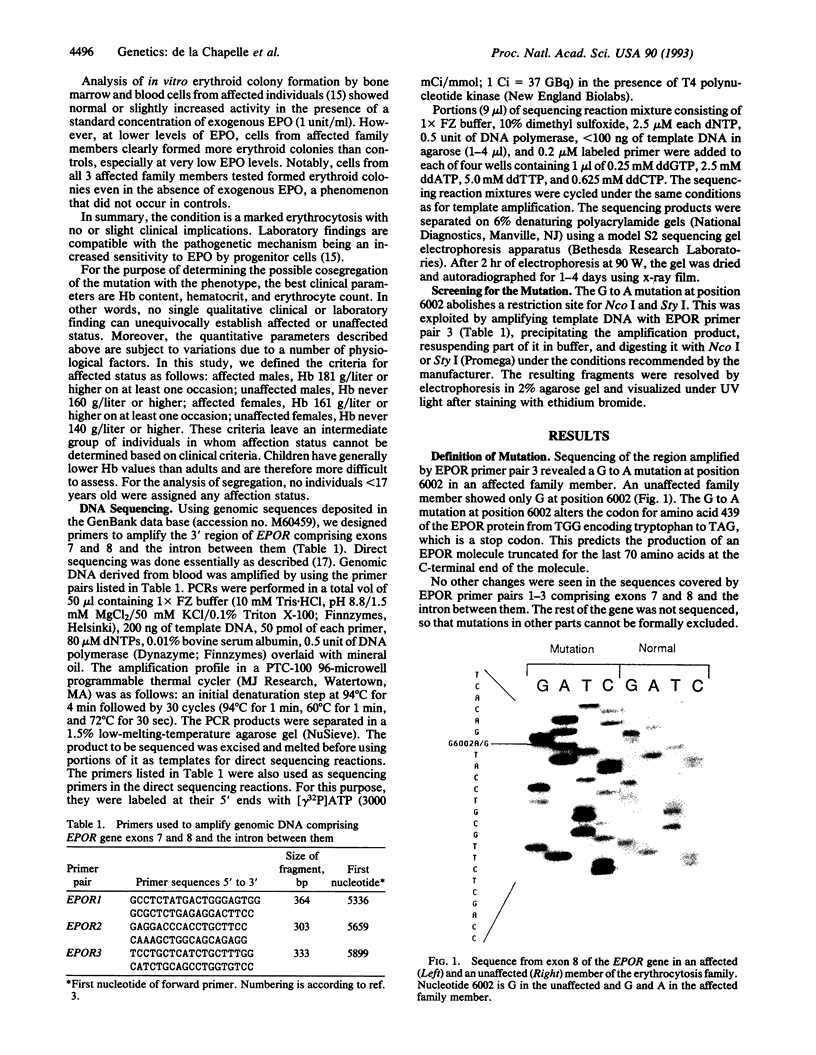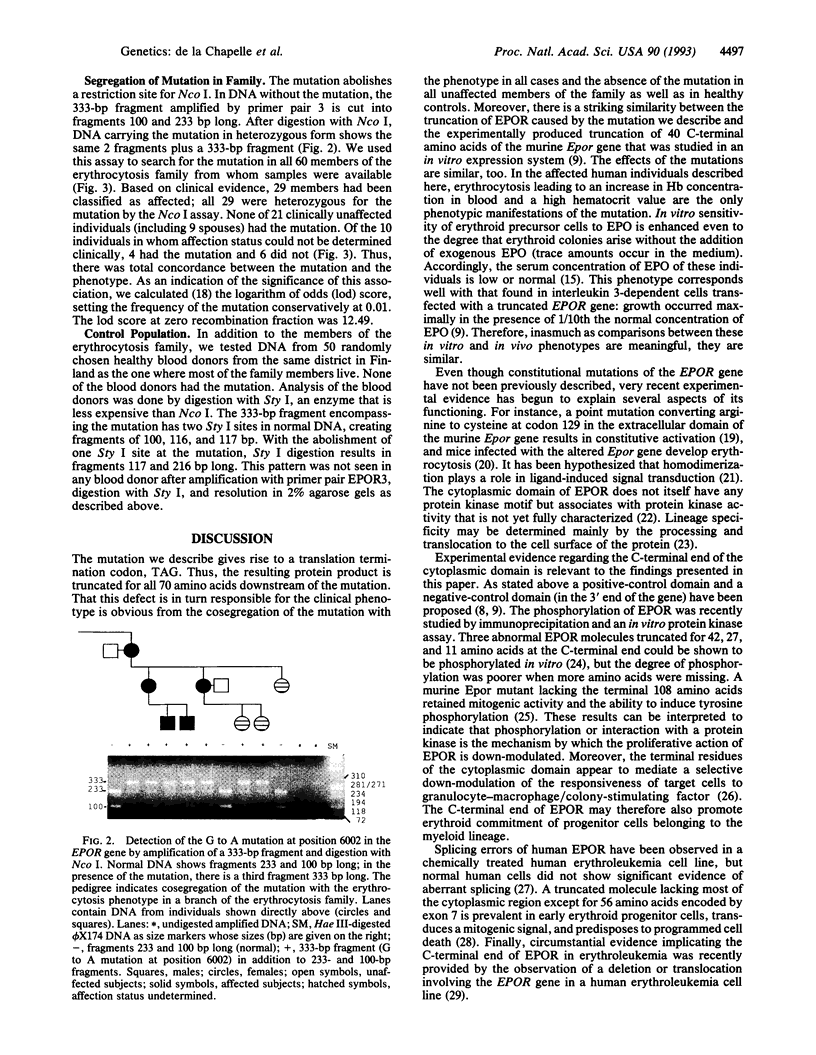Abstract
Erythropoietin regulates the proliferation and differentiation of erythroid precursor cells. Its effect is mediated by the erythropoietin receptor (EPOR), a member of a large family of cytokine receptors. The EPOR gene has recently been cloned, sequenced, and characterized. As shown experimentally, its intracellular C-terminal part contains a domain exerting negative control on erythropoiesis. Here we describe a G to A transition in nucleotide 6002 of the EPOR gene that converts a TGG codon for tryptophan into a TAG stop codon, predicting the truncation of the 70 C-terminal amino acids of the EPOR molecule. The mutation occurs in heterozygous form in the germ-line DNA of members of a large kindred in which primary erythrocytosis is segregating as a mild autosomal dominant trait. The mutation cosegregates with the disease phenotype in all 29 affected family members studied; it occurs in no unaffected family members or unrelated controls. This appears to be an example of a human condition caused by an EPOR mutation. Striking similarities exist between the human phenotype described here and phenotypes of cell lines expressing similarly truncated EPOR molecules produced experimentally. By analogy with these in vitro studies, one can hypothesize that the truncated EPOR molecules are activated by suppression of phosphorylation leading to loss of the down-modulation exerted by intact EPOR molecules. Experimental modifications of the EPOR gene may eventually have therapeutic applications.
Full text
PDF




Images in this article
Selected References
These references are in PubMed. This may not be the complete list of references from this article.
- Adamson J. W. Familial polycythemia. Semin Hematol. 1975 Oct;12(4):383–396. [PubMed] [Google Scholar]
- Cassileth P. A., Hyman G. A. Benign familial erythrocytosis. Report of three cases and a review of the literature. Am J Med Sci. 1966 Jun;251(6):692–697. [PubMed] [Google Scholar]
- Chiba T., Amanuma H., Todokoro K. Tryptophan residue of Trp-Ser-X-Trp-Ser motif in extracellular domains of erythropoietin receptor is essential for signal transduction. Biochem Biophys Res Commun. 1992 Apr 15;184(1):485–490. doi: 10.1016/0006-291x(92)91220-k. [DOI] [PubMed] [Google Scholar]
- D'Andrea A. D., Yoshimura A., Youssoufian H., Zon L. I., Koo J. W., Lodish H. F. The cytoplasmic region of the erythropoietin receptor contains nonoverlapping positive and negative growth-regulatory domains. Mol Cell Biol. 1991 Apr;11(4):1980–1987. doi: 10.1128/mcb.11.4.1980. [DOI] [PMC free article] [PubMed] [Google Scholar]
- Distelhorst C. W., Wagner D. S., Goldwasser E., Adamson J. W. Autosomal Dominant familial erythrocytosis due to autonomous erythropoietin production. Blood. 1981 Dec;58(6):1155–1158. [PubMed] [Google Scholar]
- Ehrenman K., St John T. The erythropoietin receptor gene: cloning and identification of multiple transcripts in an erythroid cell line OCIM1. Exp Hematol. 1991 Oct;19(9):973–977. [PubMed] [Google Scholar]
- Emanuel P. D., Eaves C. J., Broudy V. C., Papayannopoulou T., Moore M. R., D'Andrea A. D., Prchal J. F., Eaves A. C., Prchal J. T. Familial and congenital polycythemia in three unrelated families. Blood. 1992 Jun 1;79(11):3019–3030. [PubMed] [Google Scholar]
- Jones S. S., D'Andrea A. D., Haines L. L., Wong G. G. Human erythropoietin receptor: cloning, expression, and biologic characterization. Blood. 1990 Jul 1;76(1):31–35. [PubMed] [Google Scholar]
- Juvonen E., Ikkala E., Fyhrquist F., Ruutu T. Autosomal dominant erythrocytosis caused by increased sensitivity to erythropoietin. Blood. 1991 Dec 1;78(11):3066–3069. [PubMed] [Google Scholar]
- Lathrop G. M., Lalouel J. M., Julier C., Ott J. Strategies for multilocus linkage analysis in humans. Proc Natl Acad Sci U S A. 1984 Jun;81(11):3443–3446. doi: 10.1073/pnas.81.11.3443. [DOI] [PMC free article] [PubMed] [Google Scholar]
- Linnekin D., Evans G. A., D'Andrea A., Farrar W. L. Association of the erythropoietin receptor with protein tyrosine kinase activity. Proc Natl Acad Sci U S A. 1992 Jul 15;89(14):6237–6241. doi: 10.1073/pnas.89.14.6237. [DOI] [PMC free article] [PubMed] [Google Scholar]
- Longmore G. D., Lodish H. F. An activating mutation in the murine erythropoietin receptor induces erythroleukemia in mice: a cytokine receptor superfamily oncogene. Cell. 1991 Dec 20;67(6):1089–1102. doi: 10.1016/0092-8674(91)90286-8. [DOI] [PubMed] [Google Scholar]
- Longmore G. D., Pharr P., Lodish H. F. Mutation in murine erythropoietin receptor induces erythropoietin-independent erythroid proliferation in vitro, polycythemia in vivo. Leukemia. 1992;6 (Suppl 3):130S–134S. [PubMed] [Google Scholar]
- Maouche L., Tournamille C., Hattab C., Boffa G., Cartron J. P., Chrétien S. Cloning of the gene encoding the human erythropoietin receptor. Blood. 1991 Nov 15;78(10):2557–2563. [PubMed] [Google Scholar]
- Migliaccio A. R., Migliaccio G., D'Andrea A., Baiocchi M., Crotta S., Nicolis S., Ottolenghi S., Adamson J. W. Response to erythropoietin in erythroid subclones of the factor-dependent cell line 32D is determined by translocation of the erythropoietin receptor to the cell surface. Proc Natl Acad Sci U S A. 1991 Dec 15;88(24):11086–11090. doi: 10.1073/pnas.88.24.11086. [DOI] [PMC free article] [PubMed] [Google Scholar]
- Miura O., D'Andrea A., Kabat D., Ihle J. N. Induction of tyrosine phosphorylation by the erythropoietin receptor correlates with mitogenesis. Mol Cell Biol. 1991 Oct;11(10):4895–4902. doi: 10.1128/mcb.11.10.4895. [DOI] [PMC free article] [PubMed] [Google Scholar]
- Myers R. M., Lumelsky N., Lerman L. S., Maniatis T. Detection of single base substitutions in total genomic DNA. Nature. 1985 Feb 7;313(6002):495–498. doi: 10.1038/313495a0. [DOI] [PubMed] [Google Scholar]
- Nakamura Y., Komatsu N., Nakauchi H. A truncated erythropoietin receptor that fails to prevent programmed cell death of erythroid cells. Science. 1992 Aug 21;257(5073):1138–1141. doi: 10.1126/science.257.5073.1138. [DOI] [PubMed] [Google Scholar]
- Noguchi C. T., Bae K. S., Chin K., Wada Y., Schechter A. N., Hankins W. D. Cloning of the human erythropoietin receptor gene. Blood. 1991 Nov 15;78(10):2548–2556. [PubMed] [Google Scholar]
- Orita M., Suzuki Y., Sekiya T., Hayashi K. Rapid and sensitive detection of point mutations and DNA polymorphisms using the polymerase chain reaction. Genomics. 1989 Nov;5(4):874–879. doi: 10.1016/0888-7543(89)90129-8. [DOI] [PubMed] [Google Scholar]
- Penny L. A., Forget B. G. Genomic organization of the human erythropoietin receptor gene. Genomics. 1991 Dec;11(4):974–980. doi: 10.1016/0888-7543(91)90022-7. [DOI] [PubMed] [Google Scholar]
- Prchal J. T., Crist W. M., Goldwasser E., Perrine G., Prchal J. F. Autosomal dominant polycythemia. Blood. 1985 Nov;66(5):1208–1214. [PubMed] [Google Scholar]
- Quelle D. E., Wojchowski D. M. Localized cytosolic domains of the erythropoietin receptor regulate growth signaling and down-modulate responsiveness to granulocyte-macrophage colony-stimulating factor. Proc Natl Acad Sci U S A. 1991 Jun 1;88(11):4801–4805. doi: 10.1073/pnas.88.11.4801. [DOI] [PMC free article] [PubMed] [Google Scholar]
- Srivastava A. K., Montanaro V., Kere J. Simplified template preparation and improved direct sequencing using Taq polymerase. PCR Methods Appl. 1992 May;1(4):255–256. doi: 10.1101/gr.1.4.255. [DOI] [PubMed] [Google Scholar]
- Ward J. C., Harris K. W., Penny L. A., Forget B. G., Kitamura T., Winkelmann J. C. A structurally abnormal erythropoietin receptor gene in a human erythroleukemia cell line. Exp Hematol. 1992 Mar;20(3):371–373. [PubMed] [Google Scholar]
- Watowich S. S., Yoshimura A., Longmore G. D., Hilton D. J., Yoshimura Y., Lodish H. F. Homodimerization and constitutive activation of the erythropoietin receptor. Proc Natl Acad Sci U S A. 1992 Mar 15;89(6):2140–2144. doi: 10.1073/pnas.89.6.2140. [DOI] [PMC free article] [PubMed] [Google Scholar]
- Winkelmann J. C., Penny L. A., Deaven L. L., Forget B. G., Jenkins R. B. The gene for the human erythropoietin receptor: analysis of the coding sequence and assignment to chromosome 19p. Blood. 1990 Jul 1;76(1):24–30. [PubMed] [Google Scholar]
- Yoshimura A., Lodish H. F. In vitro phosphorylation of the erythropoietin receptor and an associated protein, pp130. Mol Cell Biol. 1992 Feb;12(2):706–715. doi: 10.1128/mcb.12.2.706. [DOI] [PMC free article] [PubMed] [Google Scholar]
- Yoshimura A., Longmore G., Lodish H. F. Point mutation in the exoplasmic domain of the erythropoietin receptor resulting in hormone-independent activation and tumorigenicity. Nature. 1990 Dec 13;348(6302):647–649. doi: 10.1038/348647a0. [DOI] [PubMed] [Google Scholar]
- Yoshimura A., Zimmers T., Neumann D., Longmore G., Yoshimura Y., Lodish H. F. Mutations in the Trp-Ser-X-Trp-Ser motif of the erythropoietin receptor abolish processing, ligand binding, and activation of the receptor. J Biol Chem. 1992 Jun 5;267(16):11619–11625. [PubMed] [Google Scholar]
- de la Chapelle A., Sistonen P., Lehväslaiho H., Ikkala E., Juvonen E. Familial erythrocytosis genetically linked to erythropoietin receptor gene. Lancet. 1993 Jan 9;341(8837):82–84. doi: 10.1016/0140-6736(93)92558-b. [DOI] [PubMed] [Google Scholar]




